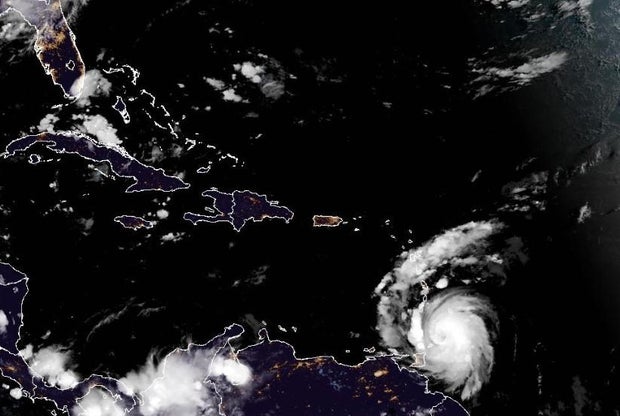Hurricane Beryl approached the southeastern Caribbean early Monday after government officials pleaded with people to take shelter from the dangerous Category 3 storm.
Beryl was expected to make landfall in the Windward Islands on Monday morning and then move across the southeastern and central Caribbean Monday night through Wednesday, the U.S. National Hurricane Center in Miami said. Hurricane warnings were in effect for Barbados, St. Lucia, Grenada, Tobago and St. Vincent and the Grenadines.
“This is a very dangerous situation,” the centre warned, adding that Beryl “is expected to bring life-threatening wind gusts and storm surges.”
From 5am EDT, Beryl was centered approximately 200 kilometers southeast of Grenada and 230 kilometers southeast of St. Vincent, running westward at 32 km per hour with maximum sustained winds of 190 km per hour. It was a compact storm, with hurricane force that extended up to 50 kilometers from the center.
NOAA / National Hurricane Center
It had strengthened to Category 4 strength on Sunday, before weakening slightly and further strength fluctuations were forecast. A hurricane needs maximum sustained winds of 130 mph to be considered a Category 4.
“It appears the hurricane is undergoing an eyewall replacement, where it temporarily weakens in exchange for a larger wind field,” said David Parkinson, senior weather and climate expert at CBS News.
A tropical storm warning was in effect for Martinique and Trinidad. A tropical storm warning was issued for Dominica, the entire southern coast of Haiti, and from Punta Palenque in the Dominican Republic westward to the Haitian border.
Beryl was expected to pass just south of Barbados on Monday morning and then enter the Caribbean Sea as a major hurricane on its way to Jamaica. The hurricane was expected to weaken by mid-week, but still remain a hurricane on its way to Mexico.
Beryl breaks records
Beryl initially strengthened to a Category 3 hurricane on Sunday morning, becoming the first major hurricane east of the Lesser Antilles on record for June, according to Philip Klotzbach, a hurricane researcher at Colorado State University.
According to hurricane expert Sam Lillo, it took only 42 hours for Beryl to grow from a tropical depression to a major hurricane. This feat has only been accomplished six times before in the history of Atlantic hurricanes, and the earliest date was September 1.
Beryl then strengthened to become the first-ever Category 4 Atlantic hurricane, defeating Hurricane Dennis, which became a Category 4 storm on July 8, 2005, said hurricane specialist and storm surge expert Michael Lowry.
“Beryl is an extremely dangerous and rare hurricane for this time of year in this area,” Lowry said in a telephone interview. “Unusual is an understatement. Beryl is already a historic hurricane and it has not yet struck.”
Hurricane Ivan was the last major hurricane to hit the southeastern Caribbean in 2004. The hurricane caused catastrophic damage to Grenada as a Category 3 storm.
“So this is a serious threat, a very serious threat,” Lowry said of Beryl.
Locals get ready
Reecia Marshall, who lives in Grenada, worked the Sunday shift at a local hotel, preparing guests and urging them to stay away from windows while keeping enough food and water for everyone.
She said she was a child when Hurricane Ivan hit and she is not afraid of Beryl.
“I know it’s part of nature. I’m fine with it,” she said. “We just have to live with it.”
Meteorologists warned of a life-threatening storm surge of up to 2.7 metres (9 feet) high in areas where Beryl makes landfall, with 7.5 to 15 centimetres (3 to 6 inches) of rain falling on Barbados and nearby islands, with up to 25 centimetres (10 inches) possible in some places.
Warm waters are fueling Beryl, with the ocean heat content in the deep Atlantic Ocean being the highest ever recorded for this time of year, says Brian McNoldy, a tropical meteorology researcher at the University of Miami.
Lowry said the water is warmer now than it would be during the peak of hurricane season in September.
According to Klotzbach, Beryl is the easternmost location where a hurricane formed in the tropical Atlantic Ocean in June. This breaks the record from 1933.
“Please take this very seriously and prepare,” said Ralph Gonsalves, the Prime Minister of St. Vincent and the Grenadines. “This is a terrible hurricane.”
Long lines formed at gas stations and supermarkets in Barbados and other islands as people rushed to prepare for a storm that quickly intensified.
Thousands of people were in Barbados for the final of the Twenty20 World Cup, cricket’s biggest event, on Saturday. Prime Minister Mia Mottley noted that not all fans were able to leave on Sunday, despite many trying to quickly change their flights.
“Some of them have never been through a storm before,” she said. “We have plans to take care of them.”
Mottley said all businesses had to close on Sunday evening and warned the airport would close overnight.
People across Barbados were preparing, including Peter Corbin, 71, who was helping his son put up plywood to protect the glass doors of his home. He said by phone that he was worried about Beryl’s impact on the islands just east of Barbados.
“That’s like a butcher cutting up a pig,” he said. “They have to make a bunker somewhere. It’s going to be difficult.”
In St. Lucia, Prime Minister Philip J. Pierre announced a national lockdown for Sunday evening and said schools and businesses would remain closed on Monday.
“Preserving and protecting lives is a priority,” he said.
Caribbean leaders prepared not only for Beryl, but also for a cluster of thunderstorms that followed the hurricane and had a 70% chance of becoming a tropical depression.
“Be on your guard,” Mottley said.
Beryl is the second named storm in what is expected to be an above-average hurricane season, running from June 1 to November 30 in the Atlantic Ocean. Earlier this month, Tropical Storm Alberto made landfall in northeastern Mexico with heavy rainfall that resulted in four deaths.
A tropical depression formed near the coastal city of Veracruz in eastern Mexico on Sunday evening, with the National Hurricane Center warning of flooding and mudslides.
The National Oceanic and Atmospheric Administration predicts that the 2024 hurricane season will likely be well above average, with between 17 and 25 named storms. The forecast calls for no fewer than thirteen hurricanes and four major hurricanes.
An average Atlantic hurricane season has 14 named storms, of which seven are hurricanes and three are major hurricanes.








